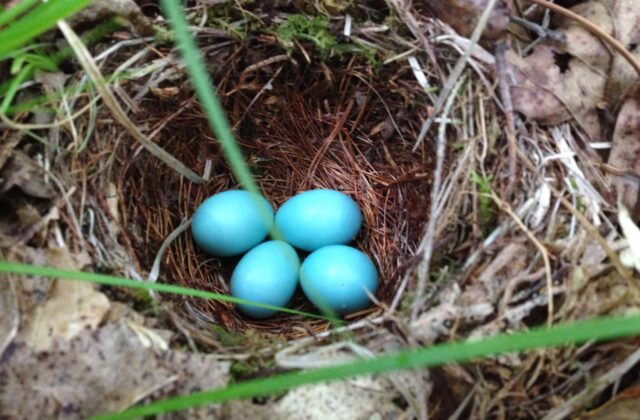What to Look For in June
Birds were busy building nests the last couple of weeks in May, and some may still be at it in June. If you are observant and lucky, you may be able to find a nest or two. Of course, birds don’t want us to know where they are going to raise their young. During construction is a great time to track where the nest is hidden. Keep an eye out for birds carrying twigs, grasses, cattail fluff, etc. Walking in the woods, you may see an ovenbird flying up from your feet. Search around for the little cave of leaves they make.
Once female birds have laid eggs, look for a male bird singing consistently from an area. That will show where the nesting territory is. Watch for birds consistently flying in to one place. Then, if you stay quietly in an inconspicuous spot to watch you may be able to see the male carrying a fat caterpillar or juicy fly to the female. Later, both male and female will be hustling to feed the nestlings. Listen for alarm cries and short calls that birds may utter when you are near a nest of young. Afternoon in good weather is the least disruptive time to look, especially once there may be eggs or young. If you have the good fortune to find a nest at whatever stage, do be sure not to linger too close or too long. Nestwatch.org has a lot of good information and offers a nest-monitoring program for citizen scientists.
A fun family activity is trying to build a nest out of twigs, bark, strands of wool, moss. It’s sure to give you a new respect for birds, who do it all with their beaks!
Of course, birds aren’t the only nest builders. June is also when the snapping turtles lay their eggs in sandy places. The best time to see this is in the early morning or evening. Snappers lay a lot of eggs (up to 40 or more), and most of the eggs, around 80 per cent, are eaten by predators. As they live a very long time, snapping turtles don’t need too many young to survive to keep up the population. The babies hatch out about two months later. Contrary to their reputation, the turtles typically swim away when they encounter humans in the water. If you come across a turtle on the road, the safest place to pick it up is by the carapace over the back legs.
Brought to you by the Norfolk Conservation Commission.

